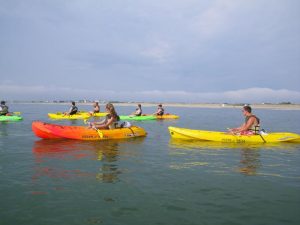Fishing, paddling with the dolphins, enjoying the serenity, getting a workout – there are many reasons that you might want to paddle in the ocean. Regardless of the reason though, the one thing that everyone must do in order to paddle in the ocean is launch from the beach – which means making it through the surf zone. In this short instructional tip I’m going to explain how to launch and land through the surf if you are paddling a sit-on-top kayak.
First of all you need to recognize what the surf is doing in the area where you want to launch. If the surf is breaking on the beach (we call that shore break) our strategy will be different than if the waves are breaking out a ways. Due to beach replenishment it seems that most of the time the Delaware beaches experience shore break. Shore break can be very dangerous. If the waves are too large, your best bet might be to pick another day. If they aren’t too big, then, with a little practice, it’s not that hard to get out.
There are several steps involved:
- Step 1: Watch the timing of the waves and wait for a break in the action. Waves usually come in sets – several waves one right after another – and then there will be a gap or break between sets where there are no, or minimal, waves coming in. This is the time you want to go.
- Step 2: Grab the bow handle of your kayak and quickly pull it out into several feet of water. This may not be very far since, in areas with shore break, the bottom drops off very quickly.
- Step 3: Jump on your kayak so that your butt is in the seat and both legs are off to the side (picture sitting on a bench) then quickly swing your legs around into the kayak.
- Step 4: Immediately start paddling away from shore. With shore break you won’t have to go very far before you can relax. The number one mistake I see people make is that they take too long to start paddling because they are fixing their seat back, adjusting their hat, messing with their paddle, etc. This can all be done once you are safely away from where the waves are breaking.
Landing in shore break is much harder than launching. It is also much more dangerous. When coming in, as I approach the beach I want to make absolutely certain that a wave does not catch me and surf me or dump me on the beach. This is a neck injury waiting to happen. A lot of times I will paddle backwards towards the beach so I can keep a close eye on the approaching waves. If a wave is coming and there is any chance it might catch me I simply paddle forwards up and over it. Once again, I wait just outside where the waves are breaking for a gap in the waves. When there is a break in the waves, I paddle towards the beach (forwards or backwards) and then jump off the kayak. It is imperative that you never get between the kayak and the beach! This is true at all times in the surf zone. Once I have bailed out I’ll simply push the kayak towards shore and let the waves take it in. I will come in well to the side of the kayak so that if it comes careening down the steep beach with the retreating wave it won’t hit me. Once on the beach I will grab the handle on the kayak and pull it up. Once again if a wave is about to hit the kayak, just let it go and don’t be caught in front of it.
With a little practice, getting in and out of the surf on a sit-on-top is not that hard. Remember a few key points: Never get between your kayak and the beach; always keep an eye on the incoming waves; launch and land between sets; be willing to go out on another day if it looks too big.
See you on the water!
-Mitch
Mitch Mitchell
ACA Open Water Instructor Trainer
ACA Level 2 SUP Instructor Trainer
BCU Level 3 Coach


